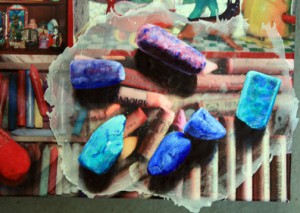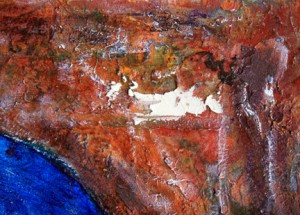In Praise of Alkyds
– by Robert Masla, – This is the unabridged version of a letter sent to The Artist’s Magazine that was edited and published in their May, 2012 issue, (pg. 8). It was a response to an article about alkyd paint written by Michael Chesley Johnson, published in the December 2011 issue
In Praise of Alkyds
Having worked in Alkyds for about 25 years, Seeing Michael Chesley Johnson’s article on Alkyds in the December issue, though long over due, was wonderfully satisfying. “Paint for the Impatient”, focuses on the advantage that alkyds dry faster than oils that makes them an attractive addition to the artists arsenal of materials, but also in many ways I believe they are likely an archivally superior alternative.
Like many contemporary artists, I work in a mixture of a variety of technical approaches drawing on the history of painting – from working en grisailles with a verdaccio, or using an imprematura with much underpainting, glazing and frottie, as well as building faux textures and employing trompe l’oeil techniques – to painting in plein air, with direct alla prima painting and lots of impasto. Like my consciousness and moods of the moment, the colors on my palette, and the particular methodology I use are always changing with the nature of the subject and feelings I wish to express while keeping open to the flow of creative energy. Prior to alkyds I use to do the initial stages of my paintings with acrylics. Still today I will sometimes use acrylic modeling paste to build up a textured surface and I often use acrylic paint to tint a high quality acrylic gesso to establish a colored ground for a painting.
Artists are creators and therefore typically innovators, but many new innovations, in materials and techniques are often shunned by “traditionalist”, (I have experienced this to a degree in presenting a technique I have created that I call “Digital Collage Paintings”, that blend together contemporary digital technology with traditional painting techniques, (see the images below, 1, 2, & 3, “Portrait of the Artist, Jane Lund”). The tradition of using rabbit skin glue for example to size a canvas before an oil priming, (in order to seal the canvas from the migration of oils that would destroy it over time), is a practice still carried out today, even though we have easily available the superior, more consistent material of acrylic polymers, (a polyvinyl acetate glue), which, when scrubbed into the fibers is less brittle, being more flexible and elastic when dry, which is particularly important on non rigid supports such as linen and canvas. The use of quality acrylic gesso, (tinted with color) on canvas or rigid supports such as wood panels, MDF or MDO board or masonite is also a positive alternative to oil priming, (no sizing needed), provided you allow it time to thoroughly dry and all water to evaporate so it is not trapped in the layer of oil or alkyd to later blister when seeking a means of escape. Just as oil paint was an “advance” over tempera, I feel “Alkyd Oils” the next step in the development of painting materials, let me explain. Some of the main problems inherent with oil paint is the long drying time as Michael pointed out in his article, making the use of many techniques, both traditional and contemporary very time consuming and often delaying spontaneity. Also, over time the paint film has a tendency to crack and colors yellow. This can be compensated to a degree by using rigid panel supports, (not very practical for large works and one of the reasons that canvas was introduced); the other is to use walnut oil instead of linseed oil (which tends to yellow). The other alternative is to use Alkyds. Remember, Alkyds where first created as an exterior paint, to resist conditions of sun, wind and rain, for house painting and sign painters. Of course, all pigmented colors are light refugent to different degrees and will eventually fade with direct exposure to the sun, but the vehicle, (linseed oil, walnut oil, sunflower oil, etc.) will also effect the color over time, (and history has yet to pass judgment on alkyds). Over the last 25 years I have used all brands of artists alkyd paints, (as well as a few “Commercial” sign painters alkyds), and of all the ones on the market today I have come to rely mostly on CasAlkydPro. They claim it offers the highest quality on the market and I would say its’ performance lives up to that claim, (according to their website, the greatest pigment content to vehicle/binder/fillers of alkyds on the market, they cite a study from the research department at the National Gallery of Art), this means a greater pigment load with a higher tinting strength. They also offer a large range of hues that dry to a semi-gloss finish = consistently brilliant color, (72 colors and 4 different mediums). The CAS Alkydpro “Gel Medium FastDry” I often recommend to my students to add to their regular oils, (along with alkyd white), to speed drying, it is thicker and faster drying then Liquin, and with oils that are sometimes already a little “runny” it adds body. Gamblin Galkyk Alkyd Medium has a viscosity in between the two. CAS also has a clear Impasto Medium for building texture as well as a Textured Impasto Medium and Textured Medium Fine, (similar to Windsor and Newtons’ “OleoPasto”). These textured mediums have a sandy, cloudy color and when mixed with other colors dries to a grainy matt which is a nice contrast to semi-gloss and gloss effects, (see detail photo 4). As in other media, oil, watercolor, etc. different manufacturers colors of the same name can vary greatly, it’s a good idea to check out the colors in comparison to what you are used to. CAS uses sunflower oil and very little mineral spirits as opposed to other brands that use linseed oil with a mixture of mineral spirits. The consistency is different, usually much thicker and pastier, and depending on pigment, dry a little quicker, (look at the comparison in photo 5). All this takes some getting used to, (take a look at the comparison photos bellow). Some of my students that I have introduced to alkyds at the workshops I teach at my studio/school in Mexico, Casa de los Artistas, say it’s like painting with glue. This can be compensated by mixing in some of the gel medium fast dry and mineral spirits or some liquin, (it will slow the drying slightly). In the tropics where the Casa is located the alkyds tend to dry even faster. I can do an underpainting in the morning and glaze on it in the afternoon, this is particularly true if I am painting in plein air in the hot Mexican sun, the paint can be dry to the touch within 2 hours, if you wish to slow the drying slightly, as I sometimes do in the Casa, use liquin, if I want it to dry even slower, then I add a painting oil, walnut, sunflower or linseed. Very different then my studio in Massachusetts where I would typically wait till the evening or next morning, (see the demo, Alkyd for Verdaccio, Frottie, and other techniques). One major downside of the CAS AlkydPro paint is the label, which is printed with a water soluble ink that runs when it gets wet, in my view a minor problem, in contrast, a nice characteristic of the label is that each color is labeled; transparent, semi-transparent, opaque, etc., a great advantage for students.
A couple of things Michael missed in his very comprehensive article. He wisely advises putting out small amounts of paint on a disposable paper palette, I often use these, but also use glass palettes which are easy to clean with a razor, and if I’ve mixed a large amount of paint, like oils, you can put it in the freezer and this will slow the drying, (you could always mix in a little oil, (walnut, linseed, etc) and it usually makes it over night). Also, very important, in the studio and particularly in your plein air kit, you’ll definitely want to pack a small pliers, (alkyd lids can often dry very hard, quickly) and like acrylics that seal over, alkyds will form a hard, sometimes thick film, especially if left unused for some time, so a small puncture tool, such as a 2-3″ finish nail or small sculptures point is a must have piece of equipment, especially when painting in plein air. If working in the studio, just as with oil, you need adequate ventilation, in my studio in MA. I have two air circulation fans and an air purifier, this is not needed in the Casa studio in Mexico, which is totally open on 3 sides, (North, East and West), and always has a nice ocean or mountain breeze circulating the air.
Robert Masla
Casa de los Artistas, Inc.
www.ArtWorkshopVacations.com
www.MaslaFineArt.com
- 1) Portrait of the Artist Jane Lund, Robert Masla, Mixed Media Digital Collage on Canvas, watercolor, gouache, watercolor canvas, acrylic gel, alkyd paint and pigmented ink, 11″x17″
- 2)Portrait of the Artist Jane Lund, detail 1, alkyd on acrylic skin, attached with acrylic matt medium
- 3) Portrait of the Artist Jane Lund, detail 2, alkyd on acrylic skin, attached with acrylic matt medium
- 4) textured impasto
- 4) comparing sap greens




































